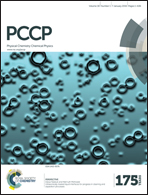Competitive lithium solvation of linear and cyclic carbonates from quantum chemistry†
Abstract
The composition of the lithium cation (Li+) solvation shell in mixed linear and cyclic carbonate-based electrolytes has been re-examined using Born–Oppenheimer molecular dynamics (BOMD) as a function of salt concentration and cluster calculations with ethylene carbonate:dimethyl carbonate (EC:DMC)–LiPF6 as a model system. A coordination preference for EC over DMC to a Li+ was found at low salt concentrations, while a slightly higher preference for DMC over EC was found at high salt concentrations. Analysis of the relative binding energies of the (EC)n(DMC)m–Li+ and (EC)n(DMC)m–LiPF6 solvates in the gas-phase and for an implicit solvent (as a function of the solvent dielectric constant) indicated that the DMC-containing Li+ solvates were stabilized relative to (EC4)–Li+ and (EC)3–LiPF6 by immersing them in the implicit solvent. Such stabilization was more pronounced in the implicit solvents with a high dielectric constant. Results from previous Raman and IR experiments were reanalyzed and reconciled by correcting them for changes of the Raman activities, IR intensities and band shifts for the solvents which occur upon Li+ coordination. After these correction factors were applied to the results of BOMD simulations, the composition of the Li+ solvation shell from the BOMD simulations was found to agree well with the solvation numbers extracted from Raman experiments. Finally, the mechanism of the Li+ diffusion in the dilute (EC:DMC)LiPF6 mixed solvent electrolyte was studied using the BOMD simulations.


 Please wait while we load your content...
Please wait while we load your content...